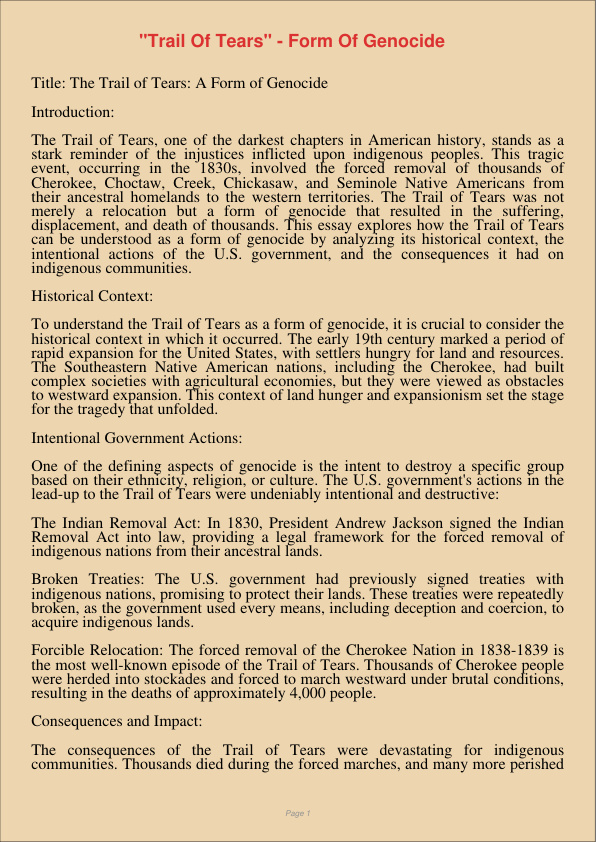Trail Of Tears Form Of Genocide
Jan 9, 2024
trail
tears
History
Marketing
Title: The Trail of Tears: A Form of Genocide
Introduction:
The Trail of Tears, one of the darkest chapters in American history, stands as a stark reminder of the injustices inflicted upon indigenous peoples. This tragic event, occurring in the 1830s, involved the forced removal of thousands of Cherokee, Choctaw, Creek, Chickasaw, and Seminole Native Americans from their ancestral homelands to the western territories. The Trail of Tears was not merely a relocation but a form of genocide that resulted in the suffering, displacement, and death of thousands. This essay explores how the Trail of Tears can be understood as a form of genocide by analyzing its historical context, the intentional actions of the U.S. government, and the consequences it had on indigenous communities.
Historical Context:
To understand the Trail of Tears as a form of genocide, it is crucial to consider the historical context in which it occurred. The early 19th century marked a period of rapid expansion for the United States, with settlers hungry for land and resources. The Southeastern Native American nations, including the Cherokee, had built complex societies with agricultural economies, but they were viewed as obstacles to westward expansion. This context of land hunger and expansionism set the stage for the tragedy that unfolded.
Intentional Government Actions:
One of the defining aspects of genocide is the intent to destroy a specific group based on their ethnicity, religion, or culture. The U.S. government’s actions in the lead-up to the Trail of Tears were undeniably intentional and destructive:
The Indian Removal Act: In 1830, President Andrew Jackson signed the Indian Removal Act into law, providing a legal framework for the forced removal of indigenous nations from their ancestral lands.
Broken Treaties: The U.S. government had previously signed treaties with indigenous nations, promising to protect their lands. These treaties were repeatedly broken, as the government used every means, including deception and coercion, to acquire indigenous lands.
Forcible Relocation: The forced removal of the Cherokee Nation in 1838-1839 is the most well-known episode of the Trail of Tears. Thousands of Cherokee people were herded into stockades and forced to march westward under brutal conditions, resulting in the deaths of approximately 4,000 people.
Consequences and Impact:
The consequences of the Trail of Tears were devastating for indigenous communities. Thousands died during the forced marches, and many more perished in the new territories due to disease, starvation, and exposure. Families were torn apart, and entire communities were decimated. The Trail of Tears also had long-lasting effects, as indigenous people faced further dispossession, loss of culture, and discrimination.
Conclusion:
The Trail of Tears, driven by the U.S. government’s policies and actions, can be unequivocally viewed as a form of genocide. It was a deliberate attempt to displace, subjugate, and destroy the indigenous nations of the Southeast, driven by the insatiable hunger for land and resources. Recognizing the Trail of Tears as a genocide is an essential step in acknowledging the historical injustices committed against Native American communities and working towards reconciliation and justice.
